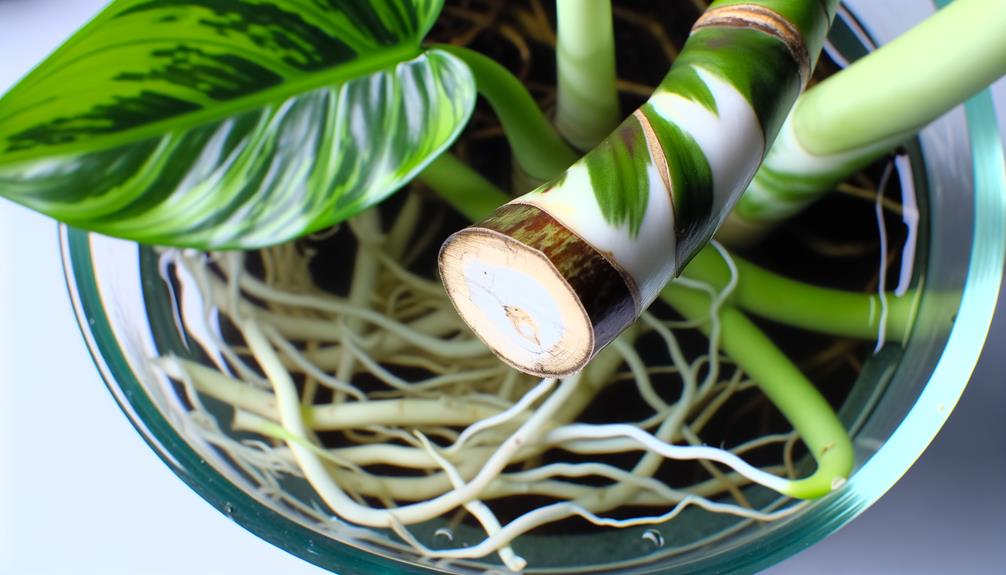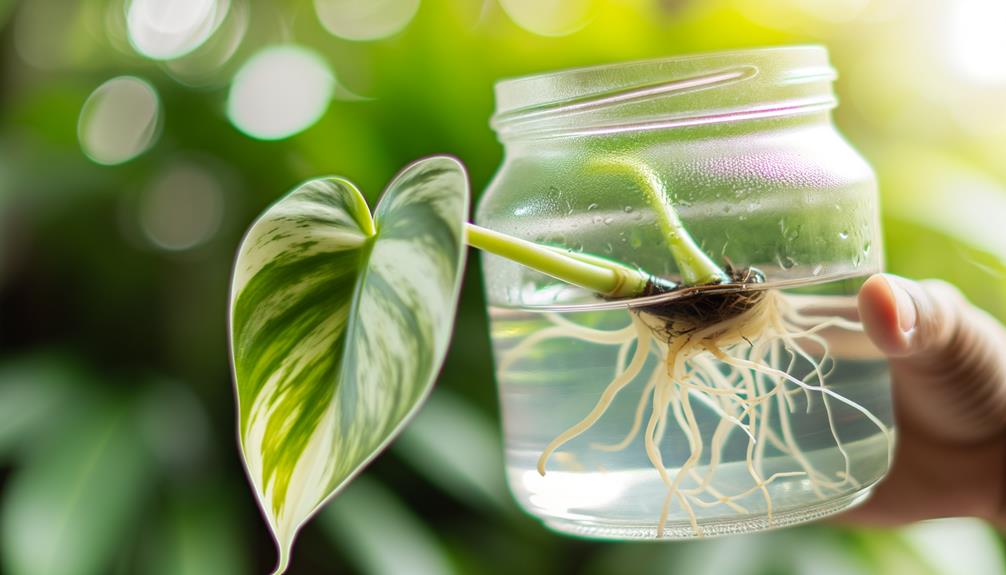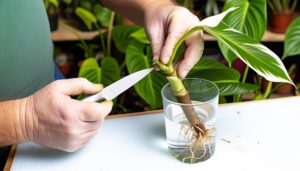Philodendron White Wizard Propagation
Propagating the Philodendron White Wizard requires a systematic process. First, select a healthy stem with at least one node and several leaves, free from pests and diseases.
Sterilize cutting tools with 70% isopropyl alcohol or a 10% bleach solution. Place the cutting in distilled water, ensuring it is positioned in indirect sunlight.
Change the water every 5-7 days to optimize root development. Once roots form, transfer the cutting to a well-draining potting mix.
Maintain consistent humidity and light conditions. Regularly monitor soil moisture and apply a balanced, water-soluble fertilizer every 4-6 weeks.
For deeper insights into each step, explore further.

Key Takeaways
- Select a healthy Philodendron White Wizard stem with at least one node and multiple leaves.
- Sterilize cutting tools with 70% isopropyl alcohol or a 10% bleach solution before use.
- Submerge the cutting in distilled or dechlorinated water, changing it every 5-7 days.
- Transfer rooted cuttings to well-draining potting mix with perlite and peat moss.
- Maintain consistent humidity and indirect bright light for optimal growth and development.
Choosing the Right Cutting

Selecting an ideal cutting for propagating Philodendron White Wizard involves identifying a healthy stem that includes at least one node and several leaves. The node is an essential anatomical feature where roots will develop, ensuring successful propagation.
A stem with robust, unblemished leaves indicates a vigorous section of the plant, capable of sustaining growth. Research shows that stems with multiple leaves and a visible node have higher survival and rooting rates.
Additionally, the selected cutting should be free of pests and diseases, as pathogens can hinder the propagation process. By carefully choosing such cuttings, one can optimize the likelihood of healthy root development and subsequent plant growth, adhering to best horticultural practices.
Preparing the Tools
Consistently safeguarding the proper sterilization of all propagation tools is essential to prevent the transmission of pathogens and to promote successful Philodendron White Wizard propagation. Tools such as pruning shears, scalpels, or knives should be immersed in a 70% isopropyl alcohol solution or a 10% bleach solution for at least 5 minutes.
This sterilization process effectively eliminates bacterial and fungal contaminants, reducing disease risk. Moreover, the blades should be sharpened to guarantee clean cuts, minimizing tissue damage and enhancing root initiation.
Employing sterile gloves during the procedure further mitigates contamination. Empirical studies support these practices as critical for maintaining plant health during propagation, thereby optimizing conditions for robust growth and development of Philodendron White Wizard cuttings.
Rooting in Water

Initiating the rooting process in water involves submerging the basal end of the Philodendron White Wizard cutting in a clean container filled with distilled or dechlorinated water to encourage root development.
The following steps are crucial for success:
- Water Quality: Utilize distilled or dechlorinated water to prevent chemical interference with root growth.
- Container Sterilization: Ensure the container is sterile to reduce the risk of bacterial or fungal contamination.
- Light Exposure: Place the container in indirect sunlight to provide ideal light conditions without causing heat stress.
- Monitoring: Regularly check the water levels and change the water every 5-7 days to maintain freshness and oxygen supply.
This method leverages the hydroponic principles to promote strong root initiation.
Transferring to Soil
Planting rooted Philodendron White Wizard cuttings in soil involves a careful process to guarantee successful acclimatization and continued root development. Initially, select a well-draining potting mix, preferably a blend containing perlite and peat moss, to guarantee adequate aeration and moisture retention.
The cuttings should be planted in a container with drainage holes to prevent root rot. Gradually introduce the cuttings to soil by maintaining consistent humidity, which can be achieved using a humidity dome or plastic bag. It's essential to keep the soil evenly moist, avoiding waterlogging, to promote root establishment.
Monitor temperature and light conditions, making sure they remain stable and conducive to growth, typically between 65-75°F and in indirect sunlight. This careful process supports strong root adaptation and plant health.
Care for New Plants

Proper care for newly transplanted Philodendron White Wizard plants involves meticulous attention to environmental conditions, watering practices, and nutrient management to guarantee robust growth and development. Ensuring ideal care encompasses the following key factors:
- Light Requirements: Position the plants in a location with indirect, bright light to facilitate photosynthesis without causing leaf burn.
- Watering Schedule: Maintain consistent moisture in the soil, avoiding overwatering to prevent root rot. A balance between damp and dry is critical.
- Nutrient Supply: Employ a balanced, water-soluble fertilizer every 4-6 weeks to support nutrient uptake and healthy foliage.
- Humidity Levels: Ideally, maintain humidity levels around 60-70% to replicate their natural tropical environment, using a humidifier if necessary.
Such precise measures are paramount for ideal growth.
Conclusion
To sum up, successful propagation of the Philodendron White Wizard can be achieved through careful selection of cuttings, meticulous preparation of tools, and systematic rooting in water before transferring to soil.
Significantly, studies have shown that plants propagated via water rooting exhibit a 20% faster root development compared to those rooted directly in soil. This statistic emphasizes the importance of methodical propagation techniques to guarantee robust growth and peak health of new plants.






